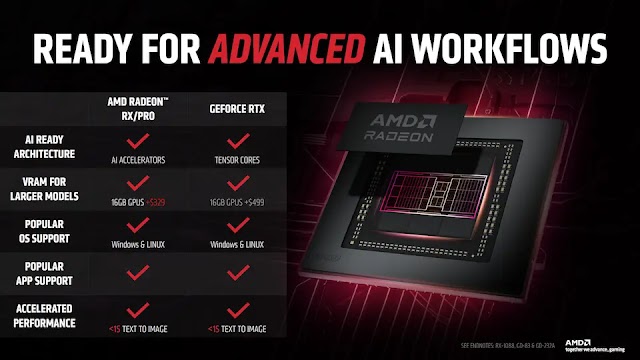Unleashing AI Power on Your PC: AMD Touts RDNA 3 GPUs and XDNA NPUs for Next-Gen Workloads
AMD is making a strong push for AI on the PC platform, highlighting the capabilities of its latest RDNA 3 GPUs and XDNA NPUs for consumer-centric workloads. This move builds upon AMD's existing lead in offering AI features to a wider audience through the XDNA NPU integrated within Ryzen APUs.
 |
| source: wccftech |
A Legacy of AI Innovation:
The first XDNA NPU arrived in 2023 with the Ryzen 7040 "Phoenix" APUs, and the technology received an upgrade with the recent Ryzen 8040 "Hawk Point" series. Beyond the NPU, AMD's RDNA 3 architecture boasts dedicated AI cores within the GPUs, further solidifying their commitment to AI on PCs.
Boosting Your Creativity and Productivity:
During a recent "Meet The Experts" webinar, AMD showcased the capabilities of its Radeon Graphics suite, including the RDNA 3 series. These advancements provide gamers, creators, and developers with a range of AI-powered tools:
Video Quality Enhancement
Background Noise Removal
Text-to-Image Generation
Large Language Model Support
Photo and Video Editing
Upscaling
Model Training (Linux Only)
RDNA 3 Delivers: Power and Performance
The latest RDNA 3 GPUs, found in both Radeon RX 7000 series GPUs and Ryzen 7000/8000 CPUs, offer more than double the AI performance compared to the previous generation. Packed with up to 192 AI accelerators optimized for FP16 workloads, these GPUs excel in popular machine learning frameworks like Microsoft DirectML, Nod.AI Shark & ROCm. Additionally, they boast large pools of dedicated VRAM (up to 48GB) and faster bandwidth thanks to Infinity Cache technology, crucial for handling massive datasets.
AMD vs. The Competition:
According to AMD, a significant portion of PC-based AI tasks rely on Large Language Models (LLMs) and Diffusion models, which heavily depend on a hardware's FP16 compute and memory capabilities. Their benchmarks showcase impressive performance gains compared to the Ryzen 7 8700G:
LM Studio:
Ryzen 7 8700G NPU: 11 Tokens/second
RX 7600 XT 16 GB: 40 Tokens/second (3.6x faster)
RX 7900 XT 20 GB: 85 Tokens/second (7.7x faster)
AMUSE Diffusion:
Ryzen 7 8700G NPU: 2.6 seconds/image
RX 7600 XT 16 GB: 0.97 seconds/image (2.7x faster)
RX 7900 XT 20 GB: 0.6 seconds/image (4.3x faster)
Beyond Performance: Value and Open Source
AMD positions itself as a value leader, highlighting that their 16GB RX 7600 XT offers significant performance improvements over the Ryzen 7 8700G NPU at a lower price point compared to NVIDIA's entry-level 16GB offering. Additionally, AMD continues to showcase strong performance against Intel's Core Ultra processors in AI tasks.
Looking forward, AMD is pushing ROCm 6.0, its open-source software suite, for broader adoption. This allows developers to leverage the power of RDNA 3 GPUs and XDNA NPUs for AI workloads on the Linux platform. While competing against established solutions like NVIDIA's CUDA and TensorRT, AMD's commitment to open source provides developers with greater flexibility and control.
The Future of AI on PC
With AMD, NVIDIA, and Intel all vying for dominance in PC-based AI, consumers can expect ongoing innovation and optimization for existing and future hardware. This competition ultimately benefits users by driving faster performance, better value, and a wider range of tools for unleashing the creative and productive potential of AI.
Want to Learn More?
Head over to AMD's website https://www.amd.com/en.html for additional information on RDNA 3 GPUs, XDNA NPUs, and the ROCm software suite.
*news sources: wccftech.com



